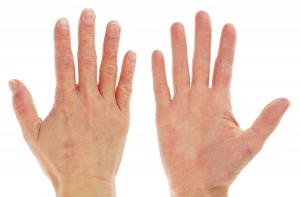The journal “Pediatrics” published a piece by Dr. Sharon Jacob and another dermatologist on Monday, containing the claim that nickel in the outer shell of Apple (NASDAQ:AAPL) iPads causes allergic skin rash in susceptible individuals. The study, Medical Xpress reports, details the case of an 11-year-old boy who suffered itching, scaly skin rashes on various parts of his body after using an Apple iPad.
As soon as the youthful Internet aficionado’s iPad was fitted with a protective cover which kept his skin from directly contacting the tablet’s metallic casing, according to the dermatologists, his rash disappeared. Exposing his skin to the metal again caused a recurrence of the irritation. This and a number of similar reports led to the “Pediatrics” publication.
 The article describes how allergic rashes caused by nickel affect approximately 3% of the adult male population and a full 17% of women, while the percentages are even higher in children of both sexes. Contact with any kind of nickel, including that in eyeglass frames, zippers, and electronics casings can potentially trigger a rash in susceptible individuals. The rash is uncomfortable and may require steroids to control. If it becomes infected, antibiotics are also needed to clear up the skin infection.
The article describes how allergic rashes caused by nickel affect approximately 3% of the adult male population and a full 17% of women, while the percentages are even higher in children of both sexes. Contact with any kind of nickel, including that in eyeglass frames, zippers, and electronics casings can potentially trigger a rash in susceptible individuals. The rash is uncomfortable and may require steroids to control. If it becomes infected, antibiotics are also needed to clear up the skin infection.
Some manufacturers avoid coating their products in nickel because it interferes with certain wireless signals. Apple (AAPL) was contacted by Medical Xpress and responded simply by saying that it uses only the highest quality materials in its products. Microsoft refused point blank to address the issue of whether its products contain nickel. Of course, nickel allergy is not really dangerous even in those relative few who are subject to it, but it is definitely uncomfortable.
In an article by Reuters, it is revealed that the iPad is a first generation device, which may mean that more recent tablets from the Cupertino company lack the metal. Thus far, no testing has been conducted to determine whether nickel is indeed present in later generations of iPad. The doctors note, however, that any electronics with a metallic surface may contain nickel, and that the same is true of other personal effects also.
Cases may be rare, or they may be underreported because people fail to make the connection between rashes on the outside of their body and their iPad. Even if the assertion proves to be accurate, the fix is relatively simple, since direct contact between skin and metal is required to trigger the allergic reaction.



